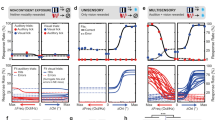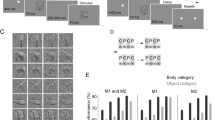Summary
To study the influence of task difficulty on the stimulus-elicited responses of inferior temporal (IT) neurons, the stimulus-elicited responses of 64 neurons were recorded from IT cortex of three rhesus monkeys while they performed three behavioral tasks — an irrelevant-stimulus task, a stimulus detection task, and a stimulus discrimination task. The monkey could ignore the stimulus entirely in the irrelevant-stimulus task, was required only to detect stimulus dimming in the stimulus detection task, and was required to attend to specific properties of the stimulus in the discrimination task. The excitatory responses in the discrimination and stimulus detection tasks were larger than those in the irrelevantstimulus task (61% and 33%, respectively, of the individual differences were significant), and excitatory responses in the discrimination task were larger than those in the detection task (49% of the individual differences reached significance). Twenty percent of the stimulus presentations elicited inhibitory responses that were followed by off-responses. The off-responses were modulated by the tasks in the same order as the excitatory on-responses. Assuming that the off-response strengths indicate the depth of the stimulus-induced inhibition, these results suggest that inhibitory responses were influenced across these tasks in a manner similar to the excitatory responses. When the neuronal responses were related to the difficulties of these tasks, both the response strength and errors were seen to be least during the irrelevant-stimulus task and greatest during the discrimination task. This relationship suggests that the visual responsiveness of IT neurons is related to the degree of attention the animal pays to the stimulus. Based on this and findings from several related studies, a more refined hypothesis can be formulated, namely, visual responsiveness of IT neurons is related to the degree of attention the animal pays to stimulus pattern, specifically.
Similar content being viewed by others
References
Bonin G von, Bailey P (1947) The neocortex of Macaca mulatta. Univ. Illinois Press, Urbana IL
Desimone R, Albright TD, Gross CG, Bruce CJ (1984) Stimulus selective properties of inferior temporal neurons in the macaque. J Neurosci 4:2051–2062
Desimone R, Gross CG (1979) Visual areas in the temporal cortex of the macaque. Brain Res 178:363–380
Evarts EV (1966) Methods for recording activity of individual neurons in moving animals. In: RF Rushmer (ed) Methods in medical research. Year Book, Chicago, pp 241–250
Fuster JM, Jervey JP (1981) Neuronal firing in the inferotemporal cortex of the monkey in a visual memory task. J Neurosci 2:361–375
Gross CG, Bender DB, Gerstein GL (1979) Activity of inferior temporal neurons in behaving monkeys. Neuropsychologia 17:215–229
Gross CG, Rocha-Miranda CE, Bender DB (1972) Visual properties of neurons in inferotemporal cortex of the macaque. J Neurophysiol 35:96–111
Hays AV, Richmond BJ, Optican LM (1982) A UNIX-based multiple process system for real-time data acquisition and control. WESCON Conf Proc 2:1–10
Iwai E, Mishkin M (1969) Further evidence on the locus of the visual area in the temporal lobe of the monkey. Exp Neurol 25:585–594
Judge SJ, Richmond BJ, Chu FC (1980) Implantation of magnetic search coils for measurement of eye position: an improved method. Vision Res 20:535–538
MacPherson JM, Aldridge JW (1979) A quantitative method of computer analysis of spike train data collected from behaving animals. Brain Res 175:183–187
Mikami A, Kubota K (1980) Inferotemporal neuron activities and color discrimination with delay. Brain Res 182:65–78
Miller Jr RG (1966) Simultaneous statistical inference. McGraw-Hill, New York
Moran J, Desimone R (1985) Selective attention gates visual processing in the extrastriate cortex. Science 229:782–784
Perrett DI, Rolls ET, Caan W (1982) Visual neurons responsive to faces in the monkey temporal cortex. Exp Brain Res 47:329–342
Richmond BJ, Optican LM, Podell M, Spitzer H (1987) Temporal encoding of two-dimensional patterns by single units in primate inferior temporal cortex. I. Response characteristics. J Neurophysiol 57:132–146
Richmond BJ, Sato T (1987) Enhancement of inferior temporal neuronal responses during visual discrimination. J Neurophysiol 58:1292–1306
Richmond BJ, Wurtz RH, Sato T (1983) Visual responses of inferior temporal neurons in the awake rhesus monkey. J Neurophysiol 50:1415–1432
Robinson DA (1963) A method of measuring eye movement using a scleral search coil in a magnetic field. IEEE Trans Bio-Med Eng BME10:137–145
Rolls ET, Judge SJ, Sanghera MK (1977) Activity of neurones in the inferotemporal cortex of the alert monkey. Brain Res 130:229–238
Sanderson AC, Kobler B (1976) Sequential interval histogram analysis of nonstationary neuronal spike trains. Biol Cybern 22:61–71
Sato T (1988) Effects of attention and stimulus interaction on visual responses of inferior temporal neuron in Macaque. J Neurophysiol 60:344–364
Spitzer H, Desimone R, Moran J (1988) Increased attention enhances both behavioral and neuronal performance. Science 240:338–340
Spitzer H, Richmond BJ (1985) Visual selective attention modifies single unit activity in inferior temporal neurons. Soc Neurosci Abstr 11:1245
Spitzer H, Richmond BJ (1985) Visual task difficulty correlates with neuronal activity in inferior temporal cortex. Perception 14:A13
Ungerleider LG, Mishkin M (1982) Two cortical visual systems. In: Engle DJ, Goodale MA, Mansfield RJW (eds) Analysis of visual behavior. MIT Press, Cambridge, pp 549–586
Wurtz RH (1969) Visual receptive fields of striate cortex neurons in awake monkeys. J Neurophysiol 32:727–742
Author information
Authors and Affiliations
Rights and permissions
About this article
Cite this article
Spitzer, H., Richmond, B.J. Task difficulty: ignoring, attending to, and discriminating a visual stimulus yield progressively more activity in inferior temporal neurons. Exp Brain Res 83, 340–348 (1991). https://doi.org/10.1007/BF00231157
Received:
Accepted:
Issue Date:
DOI: https://doi.org/10.1007/BF00231157




